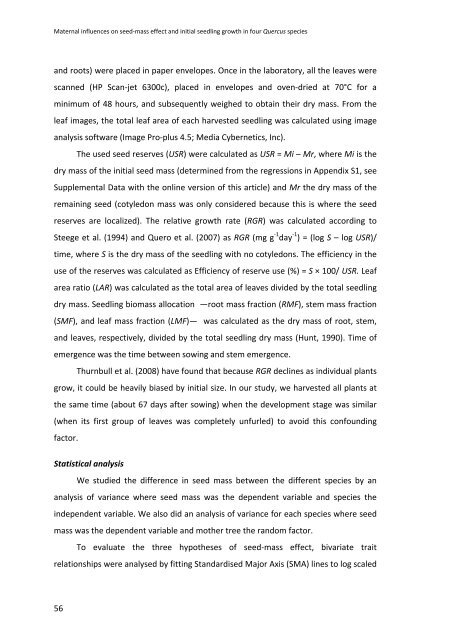Establecimiento de cuatro especies de Quercus en el sur de la ...
Establecimiento de cuatro especies de Quercus en el sur de la ...
Establecimiento de cuatro especies de Quercus en el sur de la ...
Create successful ePaper yourself
Turn your PDF publications into a flip-book with our unique Google optimized e-Paper software.
Maternal influ<strong>en</strong>ces on seed‐mass effect and initial seedling growth in four <strong>Quercus</strong> species<br />
and roots) were p<strong>la</strong>ced in paper <strong>en</strong>v<strong>el</strong>opes. Once in the <strong>la</strong>boratory, all the leaves were<br />
scanned (HP Scan‐jet 6300c), p<strong>la</strong>ced in <strong>en</strong>v<strong>el</strong>opes and ov<strong>en</strong>‐dried at 70°C for a<br />
minimum of 48 hours, and subsequ<strong>en</strong>tly weighed to obtain their dry mass. From the<br />
leaf images, the total leaf area of each harvested seedling was calcu<strong>la</strong>ted using image<br />
analysis software (Image Pro‐plus 4.5; Media Cybernetics, Inc).<br />
The used seed reserves (USR) were calcu<strong>la</strong>ted as USR = Mi – Mr, where Mi is the<br />
dry mass of the initial seed mass (<strong>de</strong>termined from the regressions in App<strong>en</strong>dix S1, see<br />
Supplem<strong>en</strong>tal Data with the online version of this article) and Mr the dry mass of the<br />
remaining seed (cotyledon mass was only consi<strong>de</strong>red because this is where the seed<br />
reserves are localized). The r<strong>el</strong>ative growth rate (RGR) was calcu<strong>la</strong>ted according to<br />
Steege et al. (1994) and Quero et al. (2007) as RGR (mg g ‐1 day ‐1 ) = (log S – log USR)/<br />
time, where S is the dry mass of the seedling with no cotyledons. The effici<strong>en</strong>cy in the<br />
use of the reserves was calcu<strong>la</strong>ted as Effici<strong>en</strong>cy of reserve use (%) = S × 100/ USR. Leaf<br />
area ratio (LAR) was calcu<strong>la</strong>ted as the total area of leaves divi<strong>de</strong>d by the total seedling<br />
dry mass. Seedling biomass allocation ―root mass fraction (RMF), stem mass fraction<br />
(SMF), and leaf mass fraction (LMF)― was calcu<strong>la</strong>ted as the dry mass of root, stem,<br />
and leaves, respectiv<strong>el</strong>y, divi<strong>de</strong>d by the total seedling dry mass (Hunt, 1990). Time of<br />
emerg<strong>en</strong>ce was the time betwe<strong>en</strong> sowing and stem emerg<strong>en</strong>ce.<br />
Thurnbull et al. (2008) have found that because RGR <strong>de</strong>clines as individual p<strong>la</strong>nts<br />
grow, it could be heavily biased by initial size. In our study, we harvested all p<strong>la</strong>nts at<br />
the same time (about 67 days after sowing) wh<strong>en</strong> the <strong>de</strong>v<strong>el</strong>opm<strong>en</strong>t stage was simi<strong>la</strong>r<br />
(wh<strong>en</strong> its first group of leaves was complet<strong>el</strong>y unfurled) to avoid this confounding<br />
factor.<br />
Statistical analysis<br />
We studied the differ<strong>en</strong>ce in seed mass betwe<strong>en</strong> the differ<strong>en</strong>t species by an<br />
analysis of variance where seed mass was the <strong>de</strong>p<strong>en</strong><strong>de</strong>nt variable and species the<br />
in<strong>de</strong>p<strong>en</strong><strong>de</strong>nt variable. We also did an analysis of variance for each species where seed<br />
mass was the <strong>de</strong>p<strong>en</strong><strong>de</strong>nt variable and mother tree the random factor.<br />
To evaluate the three hypotheses of seed‐mass effect, bivariate trait<br />
r<strong>el</strong>ationships were analysed by fitting Standardised Major Axis (SMA) lines to log scaled<br />
56

















